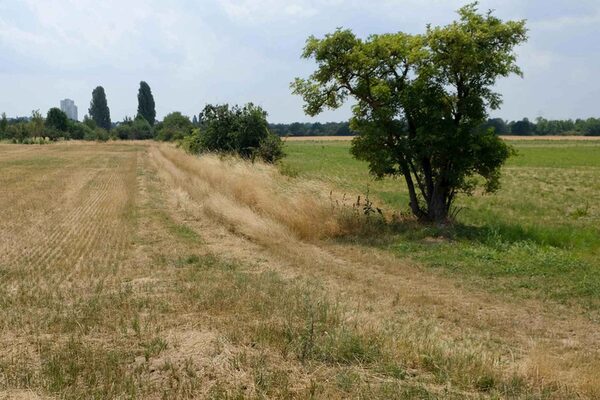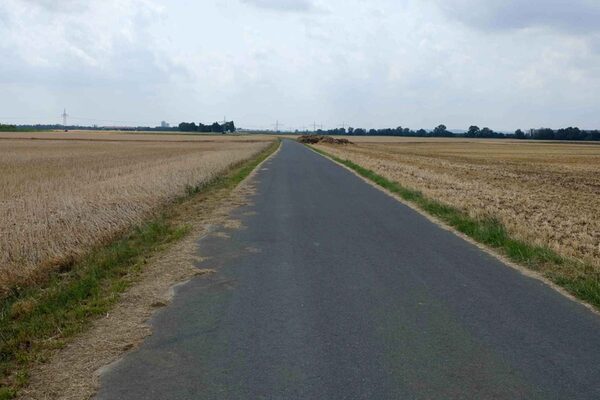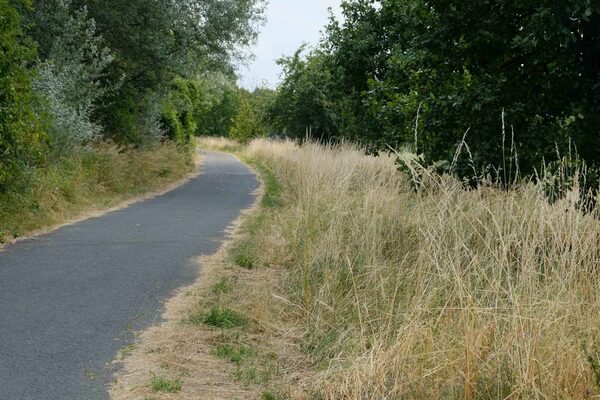Field margins as biotopes
Field margins with wild herbs and other vegetation provide a habitat for numerous insects. They are particularly important for preserving biodiversity in the agricultural landscape.
Attentive observers will notice that some roadsides and field edges in the Wiesbaden fields have appeared "untidier" in recent years than before. The vegetation on verges is taller and contains many flowering plants as well as grasses. In addition, mown and unmown sections alternate again and again. In many places, mowing takes place much later and less frequently than just a few years ago. As a rule, these changes are not due to a lack of "sense of order". They are evidence that greater importance is now attached to aspects of nature conservation.
Changes in the cultural landscape since the 1950s
Until the 1950s, the agricultural landscape in our region was largely characterized by a very varied appearance. Different types of crops were cultivated on relatively small areas separated by margins, grassland and hedges. In some areas of the district, they were interspersed with orchards. The weeds, which were not very popular with farmers, sometimes gave fields and meadows a real blaze of color. Some of us can still see them in front of our eyes: cornflowers, corncrakes, poppies and daisies. Since the middle of the 20th century, the landscape has changed dramatically. The reasons for this were the use of chemicals, mechanical intensification and ever larger cultivated areas due to the merging of fields. The result was a cultivated landscape with largely hedge-free, uniform, large monoculture areas. Although these offer high yields and a high level of yield security, they provide a habitat for fewer and fewer animal and plant species.
Biodiversity at field margins
In this "cleared agricultural steppe", green paths, roadsides and field edges are often the only remaining areas that still allow remnants of the former biodiversity to flourish. In order for wild herbs to grow in these remaining areas and for insects to find food and cover for birds or hares, it is important to give nature the opportunity to flourish. However, this requires that the areas are rarely mulched, cultivated and, if possible, not sprayed with agrochemicals.
In addition to these edge structures, there are now also larger areas in large parts of the Wiesbaden district, sometimes entire fields, which stand out from their surroundings with more diverse vegetation. These are flowering areas created by farmers to protect various animal species. And sometimes with considerable success, as demonstrated by the "Wiesbaden East Field Project", for example. Here, the creation of new habitats in the form of flowering areas, which now cover a total area of around 60 hectares, has more than doubled the numbers of partridges and brown hares within just a few years. To achieve such success, it is important not only to allow various native plants to flower in these areas, but also to leave the faded plants standing over the winter. They then provide vital food, cover and hibernation opportunities for many animals.
Untidy fields mean life
The areas in Wiesbaden's fields that appear "untidy" to some passers-by are not evidence of neglect, but rather valuable structures that contribute to greater biodiversity. They help to protect the livelihoods of plants, animals and ultimately also us humans. We should therefore enjoy the sight of them - even when they are not in colorful bloom.
You can actively support the protection of these areas by:
- Not destroying the plants growing there,
- keeping dogs on a lead so that wild animals are not disturbed by loose dogs,
- not leaving any garbage behind.
A general mutual consideration of all users of field paths also contributes to their preservation.
Contact us
Environmental Agency
Address
65189 Wiesbaden
Postal address
65029 Wiesbaden
Arrival
Notes on public transport
Bus stop Statistisches Bundesamt; bus lines 16, 22, 27, 28, 37, 45, X26, x72, 262
Telephone
Information on accessibility
- Barrier-free access is available
- The WC is barrier-free



